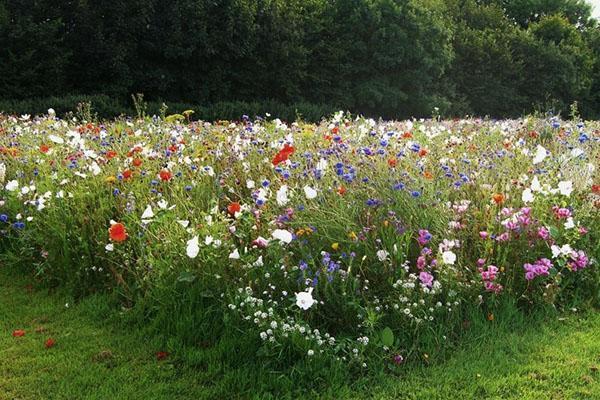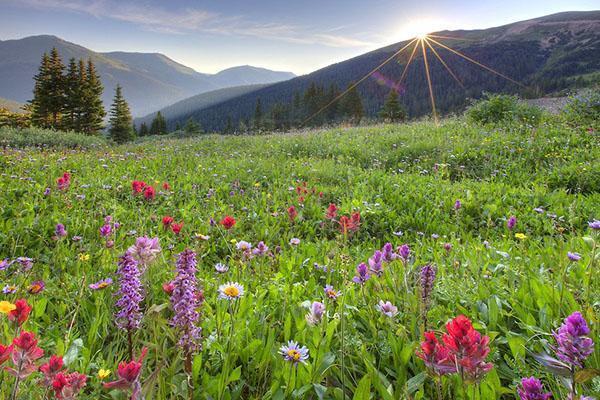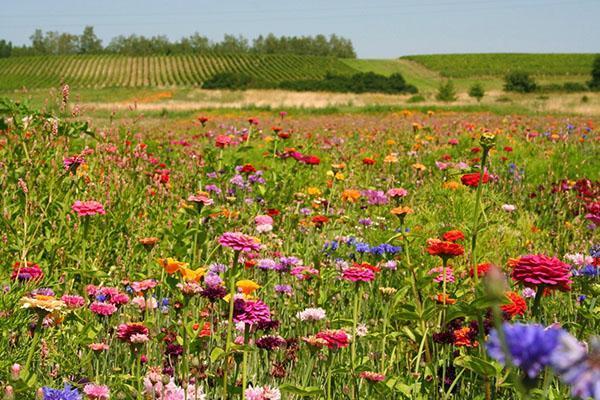Moorish lawn delights with the aroma of a flowering meadow
 Long before the appearance of the famous English lawns and green French lawns, the Moorish lawn was an integral part of the palace garden in the Middle East and North Africa. The Muslim invasion of southern Europe has left an indelible imprint on the local culture. Traits of Arab traditions can still be seen today in architecture, cooking, lifestyle and gardening.
Long before the appearance of the famous English lawns and green French lawns, the Moorish lawn was an integral part of the palace garden in the Middle East and North Africa. The Muslim invasion of southern Europe has left an indelible imprint on the local culture. Traits of Arab traditions can still be seen today in architecture, cooking, lifestyle and gardening.
Green lawns with neatly trimmed grass are no longer a rarity in home gardens. Such coatings are durable and decorative. But many owners of such lawns, or those who are just thinking about arranging their own plot, believe that a mandatory haircut is tiring. To no less skeptics, it seems that solid greenery over a vast territory is boring.
Is there an alternative to green grass? There is! Both groups of opponents of the classic English lawn can turn their attention to the Moorish lawn.
This is a one-of-a-kind grass cover that cannot be called boring or monotonous, and you will not have to mow the vegetation more than twice a season.
The Moors' love for bright colors and sweet aromas was also reflected in their preferences for gardening. As you can see in the photo, the Moorish lawn is a semblance of a wondrously blooming meadow, transferred to the palace park or to a modest summer cottage.
Pros and cons of a Moorish lawn
For many years, lawns, on which not only cereals but also ornamental plants grow freely, have been practically forgotten. Only a few years ago, interest in them began to rapidly return.
Today, patches of Moorish lawn can be found in the largest public gardens in the world. And the reason for the growing popularity is the mass of the advantages of this choice.
Blooming lawn meadow:
- does not require frequent and rather tiring haircuts;
- does not need constant attention;
- content with minimal care;
- can grow on nutrient-poor soils;
- easier to renew;
- differs in variability, since the flowering of some crops is replaced by others and continues from early spring to late autumn.
 The Moorish lawn is mowed twice. The first haircut is in early spring, when the cereals have already grown, and the perennial and annual flowers have not yet woken up. The second falls in autumn, after the seeds of flowering plants fall. The rest of the care is not much different from what a classic, green grass cover gets.
The Moorish lawn is mowed twice. The first haircut is in early spring, when the cereals have already grown, and the perennial and annual flowers have not yet woken up. The second falls in autumn, after the seeds of flowering plants fall. The rest of the care is not much different from what a classic, green grass cover gets.
But with so many advantages of the Mauritanian lawn, several of its features can be attributed to the disadvantages:
- It is not recommended to split it over a large area, otherwise the complexity of care increases dramatically, and it is much more difficult to keep track of the resettlement of plants.
- It is extremely important to correctly select the composition of the Moorish lawn, especially flowering plants. If you make a mistake, it will not be possible to create the effect of continuous flowering, or the crops that bloom in the first year in the next season will disappear without a trace from the lawn.
- It is necessary to ensure even sowing of both cereals and ornamental crops. For this, the seeds are mixed not only with each other, but also with sand.
If you carefully approach the implementation of these points, the Moorish lawn will become a wonderful and durable decoration of the site.
The composition of the Moorish lawn
 Whatever the name of the lawn, but its basis is always unpretentious perennial grains.In Russian conditions, it shows itself best of all:
Whatever the name of the lawn, but its basis is always unpretentious perennial grains.In Russian conditions, it shows itself best of all:
- meadow bluegrass;
- certain species of bent grass;
- timothy;
- perennial ryegrass.
The mixture of seeds of these plants prevails in the composition of the Mauritanian lawn and can reach 80–95% of the total volume. That is, about 5-15% remains for decorative perennials or annuals. A large amount is not required, otherwise the plantings will thicken, and the desired effect from the site cannot be achieved.
For sowing, they often use low and unpretentious plants that are not afraid of being close to other crops, have long flowering periods and easily tolerate winter. When selecting annual plants, attention is paid to their independent sowing and the ability to sprout amicably.
 Such plants in the composition of the Mauritanian lawn include:
Such plants in the composition of the Mauritanian lawn include:
- field cornflowers, which today are offered not only in traditional blue colors, but also in white, pink, lilac shades;
- undersized varieties of cosme, which dissipates on its own in the fall, and the next year grows together;
- large-flowered flax;
- calendula;
- marigold;
- nemesia;
- godetia and many other cultures.
 Among perennials on the Moorish lawn, as in the photo, you can see:
Among perennials on the Moorish lawn, as in the photo, you can see:
- all kinds of chamomile, from meadow grass to multicolored pyrethrum;
- echinacea white and pink;
- oriental poppy;
- lupins of all kinds and colors;
- aquilegia;
- rudbeckia;
- gypsophila;
- narrow-leaved lavender;
- snakehead;
- undersized varieties of delphinium;
- eschsholzia.
The choice of plants for a Moorish lawn is very large, so this garden decoration will definitely be unique and inimitable.
 And so that the lawn near the house will please the eye from early spring, unpretentious, well-wintering bulbous plants are planted on the lawn. These crops include: muscari, traditional tulips and daffodils, poultry farms and crocuses. Ornamental types of onions look very attractive among such forbs.
And so that the lawn near the house will please the eye from early spring, unpretentious, well-wintering bulbous plants are planted on the lawn. These crops include: muscari, traditional tulips and daffodils, poultry farms and crocuses. Ornamental types of onions look very attractive among such forbs.
The photos are excellent, but for our strip the mixtures of herbs will not be so interesting and bright. In addition, one can very much argue about "content with minimal maintenance": a) Weeds gladly settle on such a lawn, and because of the specifics of the vegetable "potpourri", it is very mutrono to weed them out. This business was boring. 2). The Moor looks beautiful. lawn in the event that a certain density is observed, and the total height of the grasses is maintained. Any bald spots or a strong drop of "low" plants with tall ones will not give the lawn a lot of beauty, it will rather look rather untidy. Of course, how the mixture you bought will grow is unpredictable.